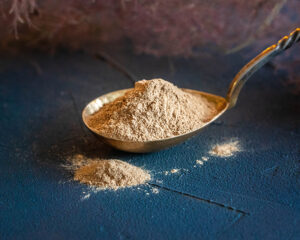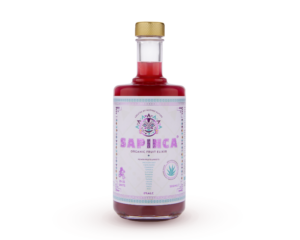Organic soya lecithin
From 1.90€
Organic soy lecithin is made from organic soybeans grown without synthetic pesticides or GMOs. After harvesting and cleaning, the soybeans are crushed to extract the soybean oil. Lecithin is obtained from soybean oil by deoxygenation and solvent extraction to organic standards. The resulting soy lecithin is carefully dried and packaged, making it a sought-after ingredient for those seeking emulsifiers and stabilizers from natural and sustainable sources.
Advantages of soy lecithin:
– Emulsifier and stabiliser. Soy lecithin is used in foods as a natural emulsifier to help mix ingredients that would otherwise separate, such as oil and water. It stabilises the texture of the food and extends the shelf life.
– Regulating cholesterol. Soy lecithin contains phospholipids, which can help lower LDL (bad) cholesterol levels. Its regular consumption can support heart health by reducing the risk of atherosclerosis.
– Brain health. Phospholipids in soy lecithin are essential components of cell membranes. Some studies suggest that lecithin may help improve memory.
– Liver health. The potential of lecithin in the prevention of liver disease has been studied. It can help break down liver fats and support liver health.
– Skin health. Soy lecithin is often used in cosmetics and skin care products because of its moisturising properties.
Attention! Allergies – Soy lecithin is derived from soybeans, so people allergic to soy should be careful. Although most of the allergenic proteins are removed during processing, traces of proteins may remain in the product. Digestive problems. Some people who take large amounts of lecithin as a food supplement may experience discomfort in the digestive tract, such as diarrhoea or stomach cramps. It is advisable to start with small doses. Drug interactions. Soy lecithin may interact with certain medicines, especially blood thinners such as warfarin. Be careful. Pregnancy and breastfeeding. Soy lecithin is usually taken with food. There is insufficient reliable information on whether it is safe to use lecithin in high doses in pregnant or breastfeeding women. Be careful.
Use of soy lecithin:
Food industry. Soya lecithin is a common ingredient in the food industry. It is used in products such as chocolate, biscuits, margarine and salad dressings to improve texture and extend shelf life. Food supplements. Lecithin supplements are available in a variety of forms, including capsules and granules. These supplements are used to improve brain function, support cardiovascular health and regulate weight. Cosmetics and skin care. Thanks to its emollient properties, soy lecithin is found in many skin care and cosmetic products. It helps to retain moisture in the skin by acting as a natural moisturiser. In conclusion, soy lecithin is a versatile and widely used ingredient with many benefits and applications. It is often added in baking to improve the texture and moisture retention of pastries, cakes and cakes. It acts as an emulsifier in salad dressings and mayonnaise, ensuring smooth mixing of oil and water components. In smoothies, soy lecithin is useful because of its ability to produce creamy, well-blended drinks. It can be used to improve the consistency of sauces. Because of its versatility, soy lecithin is a valuable addition to both sweet and savoury dishes, contributing to texture, flavour and overall quality.
The recommended daily dose of soy lecithin powder is about 1-2 tablespoons, which is about 7-14 grams.
Soy lecithin salad dressing recipe – Ingredients:
2 tablespoons of soya lecithin powder
1/4 cup warm water
3 tablespoons extra virgin olive oil (extra virgin)
2 tablespoons mild balsamic vinegar
1 clove of garlic or 1/4 teaspoon. garlic granules (optional)
1/2 tsp mustard
Salt and pepper to taste
Preparation: mix soy lecithin powder with warm water in a small bowl. Mix well until the powder is completely dissolved. It may take a few minutes, so be patient. In a separate bowl, whisk together the extra virgin olive oil, balsamic vinegar, garlic (if using) and mustard. Pour the slowly dissolved soy lecithin mixture into a bowl with the oil, vinegar and other ingredients. While pouring, keep stirring to emulsify the sauce properly. Whisk until the sauce thickens and becomes creamy. Season the sauce with salt and pepper. You can also adjust the acidity or sweetness by adding more balsamic vinegar or a little sweetener if you wish. Enhance your sauce by adding herbs such as basil, thyme or oregano. The zest of citrus fruits (lemon, lime or orange) adds freshness to the sauce. If you want a creamier sauce, you can add a spoonful of vegetable yoghurt or mayonnaise. Then your homemade soy lecithin salad dressing is ready to use!
Sources: www.medicalnewstoday.com, www.verywellhealth.com
NB! The information provided here should not be interpreted as a recommendation for treatment or other types of health problems. We recommend that you make personal health decisions after evaluating different sources of information.
100% organic soya lecithin
Energy value 2081 kJ / 497 kcal
Fats 55,23 g
- of which saturated fatty acids 14,04 g
Carbohydrates 26,6 g
- of which sugars 2,5 g
Fibre 5,9 g
Protein 7,08 g
Salt <0,5 g
Store in a dry and cool place, out of direct sunlight.











